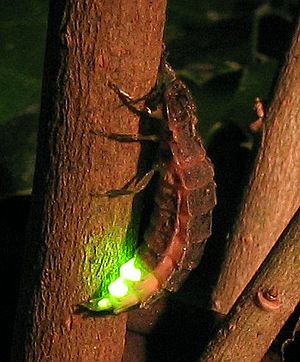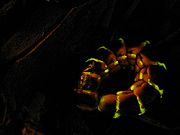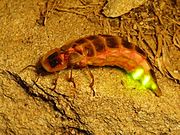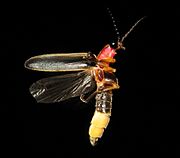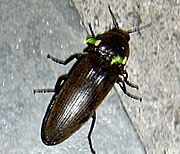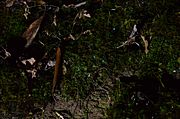Glow-worm facts for kids
A glow-worm is a cool insect that can make its own light! People also call them fireflies or lightning bugs. They are amazing creatures that light up the night.
Contents
Bioluminescent Beetles: Nature's Night Lights
Some beetles are known as "glow-worms" because they can create their own light. This special ability is called bioluminescence. Usually, it's the female beetles and their young (larvae) that glow. The males might glow too, but not always. Their light can be a steady glow or quick flashes. It often looks green, yellow, or orange.
These glowing beetles belong to four main families. They are all related and are part of a bigger group called the click beetle superfamily. Scientists think that the ability to glow might have started in one common ancestor for some of these families, but it probably developed separately in others.
Click Beetles (Elateridae)
- There are about 10,000 types of click beetles, but only about 200 of them glow.
- These glowing click beetles live in warm places like the Americas and some islands in Melanesia.
- Most of them are in a group called Pyrophorinae. One special one, Campyloxenus pyrothorax, is in a different group.
True Fireflies (Lampyridae)
- This family includes the "true" fireflies.
- There are about 2,000 different kinds of fireflies found all over the world.
Glowworm Beetles (Phengodidae)
- These beetles are often called glowworm beetles.
- About 250 species live only in the New World (North and South America).
- This family also includes railroad worms. These worms are super unique because they are the only land animals that can make red light!
Rhagophthalmidae
- About 30 species of these beetles are found in Asia.
- Scientists are still figuring out if this group should be its own family or if it belongs with the Phengodidae or Lampyridae families.
-
Phengodidae: This is a young glowworm or a female western banded glowworm (Zarhipis integripennis).
-
Lampyridae: A female common glowworm (Lampyris noctiluca) from Turkey.
-
Lampyridae: A male common eastern firefly (Photinus pyralis) from Indiana, USA.
-
Elateridae: A male headlight click beetle (Pyrophorus noctilucus) from Jamaica.
Fungus Gnats: Glowing Larvae in Caves
Some types of fungus gnats are also called "glowworms" when they are young (in their larval stage). They make a blue-green light. These larvae spin sticky webs, like spiders, to catch their food. You can find them in caves, under rocky overhangs, and in other damp, sheltered spots.
Scientists usually put these glowing gnats in the family Keroplatidae. However, some think they belong to a different family called Mycetophilidae. Even though these three types of glowworms look similar and glow, their light-making systems are different. This means they probably developed the ability to glow separately over time.
Arachnocampa
- About five species of Arachnocampa are found only in New Zealand and Australia.
- The most famous one is the New Zealand glowworm, Arachnocampa luminosa.
- These larvae are hunters! They use their lights to trick and catch small insects in their sticky webs.
Orfelia
- This group is sometimes called "dismalites."
- It has only one species, Orfelia fultoni, which lives only in North America.
- Just like Arachnocampa, these larvae are predators. They use their glow to attract prey.
Keroplatus
- These glowworms are found in Eurasia.
- Unlike the other two, Keroplatus larvae eat fungi spores.
- Scientists believe their glow doesn't have a special purpose anymore. It's like a leftover trait from their ancestors.
-
Two New Zealand glowworms (Arachnocampa luminosa) from the famous Waitomo Caves in New Zealand.
-
Orfelia fultoni glowing among the moss at Anna Ruby Falls in Georgia, USA.
Life Cycle of a Glow-Worm
Glow-worms go through a complete transformation in their lives. This is called a holometabolic life cycle. It means they change completely from an egg, to a larva (the glowing worm stage), then to a pupa, and finally to an adult insect.
For example, the glow-worms found in some caves in southeast Queensland, Australia, are a local type called Arachnocampa flava. These specific glow-worms live only in rainforest areas.
Images for kids
-
Two New Zealand glowworms (Arachnocampa luminosa) from the Waitomo Caves of New Zealand


